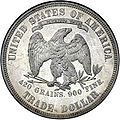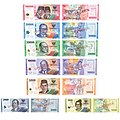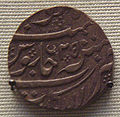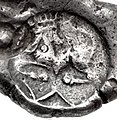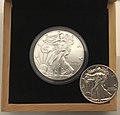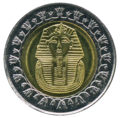Portal:Numismatics
The Numismatics Portal
stag
. Reverse: Square incuse punchNumismatics is the study or collection of currency, including coins, tokens, paper money, medals and related objects.
Specialists, known as
goods
.
The earliest forms of money used by people are categorised by collectors as "odd and curious", but the use of other goods in barter exchange is excluded, even where used as a circulating
)This is a
featured article
, which represents some of the best content on English Wikipedia..-
copper cents. Two years later, a bill was passed which authorized a three-dollar coin. By some accounts, the coin was created so larger quantities of stamps could be purchased. Longacre, in designing the piece, sought to make it as different as possible from the quarter eagle or $2.50 piece, striking it on a thinner planchet and using a distinctive design. (Full article...)
-

The Grant Memorial coinage are a gold dollar and silver half dollar struck by the United States Bureau of the Mint in 1922 in honor of the 100th anniversary of the birth of Ulysses S. Grant, a leading Union general during the American Civil War and later the 18th president of the United States. The two coins, identical in design and sculpted by Laura Gardin Fraser, portrayed Grant on the obverse and his birthplace in Ohio on the reverse.
The Ulysses S. Grant Centenary Memorial Association, also called the Grant Commission, wanted to sell 200,000 gold dollars to be able to finance multiple projects in the areas of Grant's birthplace and boyhood home. Congress authorized only 10,000 gold coins, but also authorized 250,000 half dollars. Hoping to boost sales, the Grant Commission asked for 5,000 of the gold dollars to bear a special mark, an incuse star; the Mint did the same for the half dollars as well, unasked for. (Full article...) -
Board of Lady Managers of the World's Columbian Exposition. The quarter depicts the Spanish queen Isabella I of Castile, who sponsored Columbus's voyages to the New World. It was designed by Bureau of the Mint Chief Engraver Charles E. Barber, and is the only U.S. commemorative of that denomination that was not intended for circulation.)
The Board of Lady Managers, headed by Chicago socialite Bertha Palmer, wanted a woman to design the coin and engaged Caroline Peddle, a sculptor. Peddle left the project after disagreements with Mint officials, who then decided to have Barber do the work. The reverse design, showing a kneeling woman spinning flax, with a distaff in her left hand and a spindle in her right, symbolizes women's industry and was based on a sketch by Assistant Engraver George T. Morgan. (Full article... -
commemorative coins starting in the 1950s. Beginning in 1971, members of Congress introduced bills to authorize coins to honor the United States Bicentennial, which would occur in 1976. The Mint, through its director, Mary Brooks, initially opposed such proposals, but later supported them, and Congress passed legislation requiring the temporary redesign of the reverse of the quarter, half dollar and dollar. (Full article...)
-
State of the Union address, President George Washington urged Congress to provide for a mint, which was officially authorized by the Coinage Act of 1792. Despite the authorization, silver and gold coins were not struck until 1794. The Flowing Hair dollar, designed by Robert Scot, was initially produced in 1794, and again in 1795. In October 1795 the design was replaced by the Draped Bust dollar. (Full article...)
-
U.S. Congress in the mid-1930s, members of the Westchester County Coin Club sought a half dollar for the New Rochelle anniversary. They gained the support of members of Congress, who secured the passage of legislation for the half dollar during 1936. After Wise's work was rejected, Lathrop was hired based on her work on the Albany Charter half dollar (1936). She decided to depict the "fatt calfe" which was to be presented annually to Pell if he asked for it, lest New Rochelle's land be forfeited back to him. The CFA approved her work, and the coins were struck at the Philadelphia Mint in 1937. (Full article...)
-
large cent (about the size of a half dollar) being issued by the Mint was becoming both unpopular in commerce and expensive to mint. After experimenting with various sizes and compositions, the Mint decided on an alloy of 88% copper and 12% nickel for a new, smaller cent. After the Mint produced patterns with an 1856 date and gave them to legislators and officials, Congress formally authorized the new piece in February 1857. (Full article...)
-
copper-nickel, the same alloy of which American nickels are struck today. Designed by James B. Longacre, the coin was issued from 1866 until 1883, when it was replaced by the Liberty Head nickel. The coin takes its name from the motif on its obverse, and was the first five-cent coin referred to as a "nickel"—silver pieces of that denomination had been known as half dimes.)
Silver half dimes had been struck from the early days of the United States Mint in the late 18th century. Those disappeared from circulation, along with most other coins, in the economic turmoil of the Civil War. In 1864, the Mint successfully introduced low-denomination coins, whose intrinsic worth did not approach their face value. Industrialist Joseph Wharton advocated coins containing nickel—a metal in which he had significant financial interests. When the Mint proposed a copper-nickel five-cent piece, Congress required that the coin be heavier than the Mint had suggested, allowing Wharton to sell more of the metal to the government. (Full article... -
Liberty, modeled by Anna Willess Williams, while the reverse depicts an eagle with wings outstretched. The mint mark, if present, appears on the reverse above between D and O in "Dollar".)
The dollar was authorized by the Bland–Allison Act. Following the passage of the 1873 act, mining interests lobbied to restore free silver, which would require the Mint to accept all silver presented to it and return it, struck into coin. Instead, the Bland–Allison Act was passed, which required the Treasury to purchase between two and four million dollars' worth of silver at market value to be coined into dollars each month. In 1890, the Bland–Allison Act was repealed by the Sherman Silver Purchase Act, which required the Treasury to purchase 4,500,000 troy ounces (140,000 kg) of silver each month, but only required further silver dollar production for one year. This act, once again, was repealed in 1893. (Full article... -
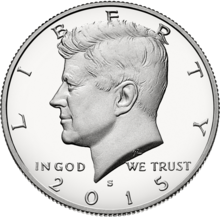
The Kennedy half dollar, first minted in 1964, is a fifty-cent coin issued by the United States Mint. Intended as a memorial to the assassinated 35th president of the United States John F. Kennedy, it was authorized by Congress just over a month after his death. Use of existing works by Mint sculptors Gilroy Roberts and Frank Gasparro allowed dies to be prepared quickly, and striking of the new coins began in January 1964.
The silver coins were hoarded upon their release in March 1964 by collectors and those interested in a memento of the late president. Although the Mint greatly increased production, the denomination was seldom seen in circulation. Continued rises in the price of silver increased the hoarding—many early Kennedy half dollars have been melted for their silver content. Starting with 1965-dated coins, the percentage of fine silver was reduced from 90% to 40% (silver clad), but even with this change the coin saw little circulation. (Full article...) -

The Eisenhower dollar is a one-dollar coin issued by the United States Mint from 1971 to 1978; it was the first coin of that denomination issued by the Mint since the Peace dollar series ended in 1935. The coin depicts President Dwight D. Eisenhower on the obverse, and a stylized image honoring the 1969 Apollo 11 Moon mission on the reverse. Both sides were designed by Frank Gasparro, with the reverse based on the mission patch designed by astronaut Michael Collins. It is the only large-size U.S. dollar coin whose circulation strikes contained no silver.
In 1965, because of rises in bullion prices, the Mint began to strike copper-nickel clad coins instead of silver. No dollar coins had been issued for thirty years, but, beginning in 1969, legislators sought to reintroduce a dollar coin into commerce. After Eisenhower died that March, there were a number of proposals to honor him with the new coin. While these bills generally commanded wide support, enactment was delayed by a dispute over whether the new dollar coin should be in base metal or 40% silver. In 1970, a compromise was reached to strike the Eisenhower dollar in base metal for circulation, and in 40% silver as a collectible. On December 31, 1970, President Richard Nixon, who had served as vice president under Eisenhower, signed legislation authorizing mintage of the new coin. (Full article...) -
Louisiana Purchase Exposition dollar, the 1916 release made him the first person to appear on two issues of U.S. coins.)
The coins were to be sold at a premium to finance the National McKinley Birthplace Memorial at Niles, Ohio, and were vended by the group constructing it. The issue was originally proposed as a silver dollar; this was changed when it was realized it would not be appropriate to honor a president who had supported the gold standard with such a piece. The coins were poorly promoted, and did not sell well. Despite an authorized mintage of 100,000, only about 30,000 were minted. Of these, 20,000 were sold, many of these at a reduced price to Texas coin dealer B. Max Mehl. The remaining 10,000 pieces were returned to the Mint for melting. (Full article... -
California Gold Rush, silver could be traded for increasing amounts of gold, so U.S. silver coins were exported and melted for their metal. This, and the reduction of postage rates to three cents, prompted Congress in 1851 to authorize a coin of that denomination made of .750 fine silver, rather than the conventional .900. The three-cent silver was the first American coin to contain metal valued significantly less than its face value, and the first silver coin not to be legal tender for an unlimited amount. The coin saw heavy use until Congress acted again in 1853, making other silver coins lighter, which kept them in circulation. Congress also lightened the three-cent silver, and increased its fineness to 900 silver. (Full article...)
-
United States Bureau of the Mint to honor the 100th anniversary of the incorporation of Bridgeport, Connecticut, as a city. Designed by Henry Kreis, the obverse depicts the showman P. T. Barnum, who was one of Bridgeport's most famous residents, was mayor of the city, helped develop it, and is buried there. The reverse depicts a stylized eagle.)
Bridgeport authorities wanted a commemorative coin to help fund the centennial celebrations. At the time, Congress was authorizing such coins for even local events, and the Bridgeport half dollar legislation passed Congress without opposition. Kreis had designed the Connecticut Tercentenary half dollar (1935), and he produced designs showing a left-facing Barnum and a modernistic eagle similar to the one on the Connecticut piece. (Full article... -
Benjamin Maximillian Mehl (November 5, 1884 – September 28, 1957), usually known as B. Max Mehl, was an American dealer in coins, selling them for over half a century. The most prominent dealer in the United States, through much of the first half of the 20th century, he is credited with helping to expand the appeal of coin collecting from a hobby for the wealthy to one enjoyed by many.
Mehl was born in Congress Poland, which was part of the Russian Empire. His family brought him to what is now Lithuania, and then to the United States, settling in Fort Worth, Texas, where he lived for almost all of his adult life. While still a teenager, he began to sell coins, which he had previously collected. Joining the American Numismatic Association (ANA) in 1903 at age 18, he quickly became a full-time coin dealer, and by 1910 was one of the most well-known in the country. (Full article...)
Selected article -

cents during the Civil War.
Selected image
Did you know...

- ...that with its Newfoundlandwas the only British colony to issue circulating gold coinage?
- ...that Canadian currency?
- ...that the American Buffalo gold bullion coin was the first .9999 fine 24-carat gold coin released by the United States Mint?
- ...that the Alabama centennial half dollar was the first commemorative coinminted with the image of a living individual?
- ...that Aksumite currency was the only native coinage to be issued in Africa without direct influence by an outside culture like Roman, Greek, etc...?
Related portals
Selected coin -
The
since the coin's introduction in 1969. , five different royal portraits have been used. there were an estimated 920 million 50p coins in circulation. The coin has proved popular withcoin collectors leading to numerous differing designs for both commemorative and circulating coins. (Full article...
)List of selected coins
|
|---|
Selected banknote image -
banknotes
.General images -
The following are images from various numismatics-related articles on Wikipedia.
-
AMughal Emperor Alamgir II (1754-1759) (from Coin)
-
Coins can be stacked. (from Coin)
-
TheAsia Minor developed the usage of portraiture from c. 420 BC. Portrait of the Satrap of Lydia, Tissaphernes (c. 445–395 BC). (from Coin)
-
The sealing of the Bank of England Charter (1694). The bank began the first permanent issue of banknotes a year later. (from Banknote)
-
The world's oldest coin, created in the ancient Kingdom of Lydia (from Currency)
-
A 7th century one-third stater coin from Lydia, shown larger (from History of money)
-
100 USD banknote (from History of money)
-
Medieval Europe in his book, The Travels of Marco Polo. (from Banknote)
-
)
-
Spade money from theZhou Dynasty, c. 650–400 BC (from History of money)
-
Silver coin of the Maurya Empire, known as rūpyarūpa, with symbols of wheel and elephant. 3rd century BC (from History of money)
-
French 1992 twenty Franc Tri-Metallic coin (from Coin)
-
When Brazil changed currencies in 1989, the 1000, 5000, and 10,000 cruzados banknotes were overstamped and issued as 1, 5, and 10 cruzados novos banknotes for several months before cruzado novo banknotes were printed and issued. Banknotes can be overstamped with new denominations, typically when a country converts to a new currency at an even, fixed exchange rate (in this case, 1000:1). (from Banknote)
-
Chinese round coins,Warring States Period, c. 300–220 BC. Four Hua (四化, 30mm, 6.94 g). Legend Yi Si Hua ([City of] Yi Four Hua). (from Coin)
-
Gandharan "bent-bar" punch-marked coin minted under Achaemenid administration, of the type found in large quantities in the Chaman Hazouri and the Bhir Mound hoards. (from Coin)
-
Hoard of mostlyMauryan Empire coins, 3rd century BC (from Coin)
-
Song dynasty Jiaozi, the world's earliest paper money. (from Banknote)
-
AnLate Bronze Age metal ingots were given standard shapes, such as the shape of an "ox-hide", suggesting that they represented standardized values. (from Coin)
-
Banknotes with a face value of ten in the United States dollar, pound sterling as issued by the Bank of England, and euro. (from Banknote)
-
Earliest banknote from China during the Song Dynasty which is known as "Jiaozi" (from History of money)
-
Cowry shells being used as money by an Arab trader (from Currency)
-
1884 United States trade dollar (from Coin)
-
Alexander the Great Tetradrachm from the Temnos Mint, c. 188–170 BC (from Coin)
-
A $5 note issued by Citizens Bank of Louisiana in the 1850s. (from Banknote)
-
A Swiss ten-cent coin from 1879, similar to the oldest coins still in official use today (from Coin)
-
A 2000 Romanian lei polymer banknote (from Banknote)
-
A 5 euro note so badly damaged it has been torn in half. The note has later been repaired with tape. (from Banknote)
-
Five million mark coin (monetary value dropped to a tiny fraction of a US cent by the end of 1923, substantially less than the value of its metallic content. (from Coin)
-
Collage for banknote design with annotations and additions to show proposed changes (figure rather higher so as to allow room for the No.), Bank of Manchester, UK, 1833. On display at the British Museum in London (from Banknote)
-
Many currencies, such as the Indonesian rupiah, vary the sizes of their banknotes by denomination. This is done so that they may be told apart through touch alone. (from Banknote)
-
Athenian coin (c. 500/490–485 BC) discovered in theAncient India. This coin is the earliest known example of its type to be found so far east. (from Coin)
-
Shredded and briquettedUS dollar notes from the Federal Reserve Bank of New York (approx. 1000 pieces, 1 kg) (from Banknote)
-
ThePondicherry. (from History of money)
-
Shredded and briquetted US dollar notes from the Federal Reserve Bank of New York (approx. 1000 pieces, 1 kg) (from Banknote)
-
Shredded and briquetted euro banknotes from the Deutsche Bundesbank, Germany (approx. 1 kg) (from Banknote)
-
Shreds of unfitUS dollar notes with a typical size of less than 1.5 mm × 16 mm (from Banknote)
-
Silver stater of Aegina, 550–530 BC. Obv. Sea turtle with large pellets down centre. Rev. incuse square punch with eight sections. (from Coin)
-
A Yuan dynasty printing plate and banknote with Chinese words. (from Banknote)
-
Name of currency units by country, in Portuguese (from Currency)
-
Song dynasty Jiaozi, the world's earliest paper money (from Currency)
-
A siglos found in the Kabul valley, 5th century BC. Coins of this type were also found in the Bhir Mound hoard. (from Coin)
-
Obverse and reverse of an old American $100 note (1928) (from Banknote)
-
Greekdrachm of Aegina. Obverse: Land turtle. Reverse: ΑΙΓ(INA) and dolphin (from History of money)
-
The taka was widely used across South Asia during the sultanate period. (from History of money)
-
The first paper money in Europe, issued by the Stockholms Banco in 1666. (from Banknote)
-
The earliest inscribed coinage:Stag grazing right, ΦΑΝΕΩΣ (retrograde). Reverse: Two incuse punches, each with raised intersecting lines. (from Coin)
-
An American Silver Eagle minted in 2019 (left), an example of a Bullion coin. Its obverse design is based on the older, formerly circulating silver Walking Liberty half dollar (right). (from Coin)
-
Posthumous Alexander the Great tetradrachm from Temnos, Aeolis. Dated 188–170 BC. Obverse: Alexander the Great as Herakles facing right wearing the nemean lionskin. Reverse: Zeus seated on throne to the left holding eagle in right hand and scepter in left; in left field PA monogram and angular sigma above grape vine arching over oinochoe; ALEXANDROU vertical in right field. Reference: Price 1678. (from Coin)
-
The Piloncitos are tiny engraved gold coins found in the Philippines, along with barter rings, which are gold ring-like ingots. These barter rings are bigger than softballs in size and are made of pure gold from the Archaic period (c. 10th to 16th century). (from Coin)
-
Punch-marked coin minted in the Kabul Valley under Achaemenid administration, c. 500–380 BC, or c. 350 BC. (from Coin)
-
Bimetallic Egyptian one pound coin featuring King Tutankhamen (from Coin)
-
Fifty-five-dollar bill inContinental currency; leaf design by Benjamin Franklin, 1779 (from Banknote)
-
Holographic coin from Liberia features the Statue of Liberty (Liberty Enlightening the World) (from Coin)
-
Fed Shreds as souvenir from the Federal Reserve Bank of San Francisco (from Banknote)
Numismatic terminology
- Bullion – Precious metals (platinum, gold and silver) in the form of bars, ingots or plate.
- Error – Usually a mis-made coin not intended for circulation, but can also refer to an engraving or die-cutting error not discovered until the coins are released to circulation. This may result is two or more varieties of the coin in the same year.
- Exonumia – The study of coin-like objects such as token coins and medals, and other items used in place of legal currency or for commemoration.
- Fineness – Purity of precious metal content expressed in terms of one thousand parts. 90% is expressed as .900 fine.
- banknotes.
- Scripophily – The study and collection of stocks and Bonds.
More terminology
WikiProjects
Numismatic topics
Terminology
Ancient currency:
Indian coinage
Modern currency: Africa - The Americas - Asia and the Pacific - Europe - Bullion coins - Challenge coin - Commemorative coins - Token coins
Economics:
Monetary union - Reserve currency - Stocks
Production:
List articles
Subcategories
Most traded currencies
| Rank | Currency | ISO 4217 code |
Symbol or abbreviation |
Proportion of daily volume | Change (2019–2022) | |
|---|---|---|---|---|---|---|
| April 2019 | April 2022 | |||||
| 1 | U.S. dollar | USD | US$ | 88.3% | 88.5% | |
| 2 | Euro | EUR | € | 32.3% | 30.5% | |
| 3 | Japanese yen | JPY | ¥ / 円 | 16.8% | 16.7% | |
| 4 | Sterling | GBP | £ | 12.8% | 12.9% | |
| 5 | Renminbi | CNY | ¥ / 元 | 4.3% | 7.0% | |
| 6 | Australian dollar | AUD | A$ | 6.8% | 6.4% | |
| 7 | Canadian dollar | CAD | C$ | 5.0% | 6.2% | |
| 8 | Swiss franc | CHF | CHF | 4.9% | 5.2% | |
| 9 | Hong Kong dollar | HKD | HK$ | 3.5% | 2.6% | |
| 10 | Singapore dollar | SGD | S$ | 1.8% | 2.4% | |
| 11 | Swedish krona | SEK | kr | 2.0% | 2.2% | |
| 12 | South Korean won | KRW | ₩ / 원 | 2.0% | 1.9% | |
| 13 | Norwegian krone | NOK | kr | 1.8% | 1.7% | |
| 14 | New Zealand dollar | NZD | NZ$ | 2.1% | 1.7% | |
| 15 | Indian rupee | INR | ₹ | 1.7% | 1.6% | |
| 16 | Mexican peso | MXN | MX$ | 1.7% | 1.5% | |
| 17 | New Taiwan dollar | TWD | NT$ | 0.9% | 1.1% | |
| 18 | South African rand | ZAR | R | 1.1% | 1.0% | |
| 19 | Brazilian real | BRL | R$ | 1.1% | 0.9% | |
| 20 | Danish krone | DKK | kr | 0.6% | 0.7% | |
| 21 | Polish złoty | PLN | zł | 0.6% | 0.7% | |
| 22 | Thai baht | THB | ฿ | 0.5% | 0.4% | |
| 23 | Israeli new shekel | ILS | ₪ | 0.3% | 0.4% | |
| 24 | Indonesian rupiah | IDR | Rp | 0.4% | 0.4% | |
| 25 | Czech koruna | CZK | Kč | 0.4% | 0.4% | |
| 26 | UAE dirham | AED | د.إ | 0.2% | 0.4% | |
| 27 | Turkish lira | TRY | ₺ | 1.1% | 0.4% | |
| 28 | Hungarian forint | HUF | Ft | 0.4% | 0.3% | |
| 29 | Chilean peso | CLP | CLP$ | 0.3% | 0.3% | |
| 30 | Saudi riyal | SAR | ﷼ | 0.2% | 0.2% | |
| 31 | Philippine peso | PHP | ₱ | 0.3% | 0.2% | |
| 32 | Malaysian ringgit | MYR | RM | 0.2% | 0.2% | |
| 33 | Colombian peso | COP | COL$ | 0.2% | 0.2% | |
| 34 | Russian ruble | RUB | ₽ | 1.1% | 0.2% | |
| 35 | Romanian leu | RON | L | 0.1% | 0.1% | |
| 36 | Peruvian sol | PEN | S/ | 0.1% | 0.1% | |
| 37 | Bahraini dinar | BHD | .د.ب | 0.0% | 0.0% | |
| 38 | Bulgarian lev | BGN | BGN | 0.0% | 0.0% | |
| 39 | Argentine peso | ARS | ARG$ | 0.1% | 0.0% | |
| … | Other | 1.8% | 2.3% | |||
| Total[a] | 200.0% | 200.0% | ||||
Web resources
- NumisWiki
- International Association of Professional Numismatists
- American Numismatic Association
- American Numismatic Society
- British Numismatic Association
- American Vecturist Association
- Challenge Coin Association
- Numismatic Museum of Athens, Greece
- The Perth Mint Australia
- Central Mint of China
- Royal Mint
- The French Mint
- United States Mint
- Bank of Russia
- Royal Canadian Mint
- Exact Change numismatic software
Things you can do
|
|
 |
Here are some tasks awaiting attention:
|
Associated Wikimedia
The following Wikimedia Foundation sister projects provide more on this subject:
-
Commons
Free media repository -
Wikibooks
Free textbooks and manuals -
Wikidata
Free knowledge base -
Wikinews
Free-content news -
Wikiquote
Collection of quotations -
Wikisource
Free-content library -
Wikiversity
Free learning tools -
Wiktionary
Dictionary and thesaurus
Sources
- ^ "Triennial Central Bank Survey Foreign exchange turnover in April 2022" (PDF). Bank for International Settlements. 27 October 2022. p. 12. Archived (PDF) from the original on 2022-10-27. Retrieved 2022-10-29.
- ^ The total sum is 200% because each currency trade is counted twice: once for the currency being bought and once for the one being sold. The percentages above represent the proportion of all trades involving a given currency, regardless of which side of the transaction it is on. For example, the US dollar is bought or sold in 88% of all currency trades, while the euro is bought or sold in 31% of all trades.
Discover Wikipedia using portals





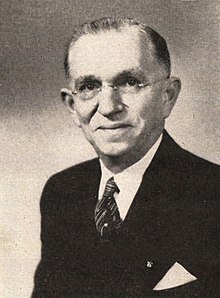

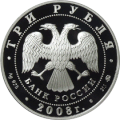



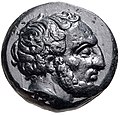









![Image 16Chinese round coins, Eastern Zhou dynasty – Warring States Period, c. 300–220 BC. Four Hua (四化, 30mm, 6.94 g). Legend Yi Si Hua ([City of] Yi Four Hua). (from Coin)](http://upload.wikimedia.org/wikipedia/commons/thumb/f/f9/CHINA%2C_Eastern_Zhou_dynasty_-_Warring_States_Period._State_of_Q%C3%AD._City_of_Yi._Circa_300-220_BC.jpg/120px-CHINA%2C_Eastern_Zhou_dynasty_-_Warring_States_Period._State_of_Q%C3%AD._City_of_Yi._Circa_300-220_BC.jpg)







